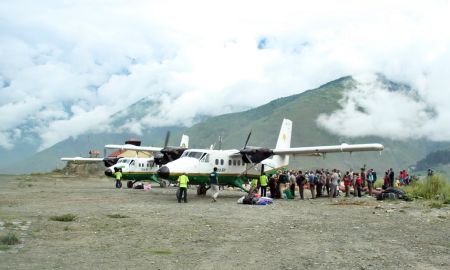Nepal’s traditional handicraft sector that connects its past to its present can also help create a unique experience for tourists.
--BY ANUTARA SHAKYA
In a modern world of automated and machine-made products, a handcrafted item intrigues anyone. Products made by hand each have a story of their own. Each crafted item, shaped, reshaped and mastered carefully results in unique art pieces that are slightly different from the other because no two handmade products can turn out exactly the same. In Nepal’s cultural history, handicraft has been a skill that has been handed down through the generations. It is a living heritage with techniques passed down mostly through oral history. These handicrafts served religious and utilitarian purposes, some, still being used in our daily lives today. Today, many businesses still thrive with the export and selling of handicraft products ranging from metal statues of gods to woolen carpets.
But despite the ability and skills of Nepali craftsmen, the handicraft sector has not been explored for its full potential in tourism. Heritage sites such as Patan Durbar Square and Bhaktapur Durbar Square have managed to preserve some of their components but the artisan skills that made the heritage sites famous are hidden deep within the alleys of the city, unexposed to the curious eyes of tourists.
While traditional handicrafts can be seen displayed in shops and showrooms in all major tourist hot spots, very few actually promote the process of producing such items and the stories of craftsmen behind it. In order for handicraft to flourish as a part of a tour by connecting tourists to artisans and their works, a lot needs to be done.
“Tourism and handicraft go hand in hand for Nepal,” says Madhusudhan Acharya, President of Nepal Association of Tours and Travel Agents (NATTA). “UNESCO heritage sites such as Patan and Bhaktapur are living museums showcasing some of the best artworks of Nepali artisans,” he adds. But despite the lure that the domestic handicraft industry possesses and its potential to generate a new tourism sector in its own right, it has really flourished only as a form of trade handed down from one generation to the next.
Artisans Village: A Way to Promote Handicrafts
Promoting handicraft tourism isn’t just about displaying and selling the handicraft products in tourist areas. It is about allowing tourists to actually understand the skill and craft behind it and appreciate Nepal’s unique traditions. Thus, when it comes to handicraft tourism, linking tourists to the artisans to help them understand and appreciate the art is important.
Handicraft tourism, however, is not a new concept in Nepal. Karna Shakya, one of Nepal’s renowned hoteliers and the Founding Chairman of KGH Group of Hotels, has, in the past, seen the potential of handicraft tourism. “I envisioned an artisan’s village to be built in Pyangaon, 14 km south of Kathmandu back in 2009, for Nepal Tourism Year 2011,” Shakya says. Pyangaun is an old Newari settlement that is known for its bamboo buckets of various sizes used to measure grains.
“The proposed Craft Village would span an area of 25 square km and would display the traditional artisans at work including woodwork, stone carving and pottery. The concept is that the village should be small enough for the visitors to be able to roam around and cover everything within the area in an hour to 45 minutes,” he explains. While the proposal for the Craft Village was approved, no action has been taken by Nepal Tourism Board so far.
Pravin Chitrakar, founder of Yala Mandala studio in Patan, had a similar plan to promote Patan’s traditional handicraft. He created a small space to showcase the work of artisans in his studio by providing incentives for them. “It wasn’t easy to bring the artisans out of their homes. They want to keep their traditional techniques a secret,” says Chitrakar.
Developing Craft Villages
Old settlements similar to Pyangaon such as Bungamati famous for their wooden crafts can be transformed into artisan villages. There are examples in other countries where the establishment of craft villages has helped tourism to flourish. Vietnam, for instance, can be viewed as a perfect example in handicraft tourism. There are more than 1,300 artisan villages in the Southeast Asian nation that are engaged in a large number of handicraft activities. There are villages for traditional hat making, bamboo weaving, embroidery and lace, paper making and folk painting, pottery and production of handcrafted porcelain items. Nepal with its rich culture and abundant artisan skills can follow suit to create such villages that not only preserve the ancient traditions but also become a means to provide employment to thousands.
Experts suggest that in order to help artisan villages flourish, a proper action plan should be drafted and implemented in collaboration with NATTA, handicraft artisans, Nepal Tourism Board and historians. According to them, it will help in predicting the flow of tourists in such areas by designing appropriate tour packages.
Pyangaun Craft Village proposed by Karna Shakya and his team has outlined a plan to provide artisans in craft villages with incentives and proper coaching to help them interact better with tourists. “Similarly, craft villages should be built on the community’s natural and cultural beauty and avoid any modern structures as much as possible,” reads Shakya and his team’s proposal. According to it, at the same time, these villages need to include services required for the tourists such as restrooms, restaurants and souvenir shops. “The engagement of local communities and their ownership of such villages will result in an important deed,” the proposal notes.

Promotion and Preservation
While the handicraft market inside the Kathmandu Valley is thriving thanks to the demand from art collectors and Nepalis and foreigners who buy items such as statues of gods, Paubha paintings and singing bowls as souvenirs and for various religious purposes, the condition of the handicraft industry outside the capital valley is dire. “The handicraft industry in Kathmandu has flourished despite the various odds. But the condition of traditional skills outside the valley is concerning. The works of local artisan are overlooked, skills are not preserved and the craftsmanship is in the verge of dying out,” says Shakya.
A small number of handicraft artisans constantly travel to international expos to promote their work. “Promotional campaigns can be done through such artisans during the expos to help promote handicraft tour packages as well,” says Madhusudhan Acharya. Itineraries can be built with proper planning, to help attract such packages to a niche group. “Older tourists from Japan, China and European countries are attracted towards such crafts. Hence packages can be designed especially for these groups of tourists according to the different products that they admire such as felt products, metal craft or Pashmina scarves,” adds Acharya.
But promoting handicrafts is not enough as Pravin Chitrakar points out the need to protect the authenticity in the handicraft sector and to support its development according to the time in order to create a base for the new type of tourism. According to him, if handicraft tourism is to flourish, it needs to be preserved.
“This is not just a job for one institution. The government, community and private sector need to work together to help create a booming tourism sector while at the same time, prevent it from exploitation and becoming too commercialised,” Chitrakar expresses. “We cannot promote handicrafts unless we ourselves learn to respect the skill and craft of the artisans. These days, people consider handicraft to be a low level job and don’t appreciate the art behind it. This perception needs to change before we can develop handicraft as a means for tourism,” he adds.






















